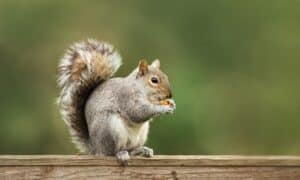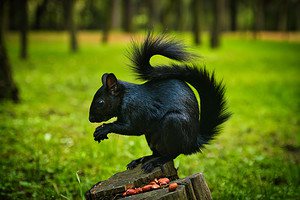1. Animals That Store Their Food: Squirrels

Depending on the species, squirrels may practice larder hoarding, scatter caching, or a mixture of these food storing strategies.
©Photographic Views/Shutterstock.com
Over 200 species of squirrels (family Sciuridae) occur across the world from tropical rainforest environments to semiarid deserts. Although the species can differ greatly in physical characteristics, habitat, and social structure, the vast majority practice food storage or caching. Generally, these rodents cache thousands of nuts and seeds throughout the spring, summer, and early fall in preparation for winter.
Depending on the species, a squirrel may spread out its store in scattered caches or consolidate the food in a central bank, a process known as larder hoarding. Some species engage in a mixed strategy of scattered caches and centralized storage. Chipmunks of the Tamias genus tend to employ both scattered caching and larder hoarding. In contrast, the eastern gray squirrel (Sciurus carolinensis) primarily practices only scatter caching. The eastern gray squirrel can hide hundreds of caches yearly, totaling thousands of stored nuts and seeds. Since they typically only recover up to 80% of their caches, the scatter storers play a vital role in seed dispersal.
2. Western Scrub Jay (Aphelocoma californica)

The western scrub jay is an expert of scatter caching.
©Pierre Leclerc/Shutterstock.com
While many species of birds practice food storing, the western scrub jay (Aphelocoma californica) is particularly well-known for its skill and speed in caching. During the fall, this scrub jay scatters caches of seeds and acorns in little stashes across their territory as a food source during winter. They may store up to about 6,000 seeds and 5,000 acorns across over 200 caches in a single season.
These clever birds use a number of tactics to minimize cache theft from conspecifics and other animals that consume nuts and seeds. Studies show that the western scrub jay will preferentially hide their cache in substrates that match the color of the food to better camouflage their stash. They will also choose shady spots that are less conspicuous and locations with substrates that don’t make a lot of noise when burying their stash.
3. Animals That Store Their Food: Red Fox (Vulpes vulpes)

Red foxes use scatter caching to store excess kills and scavenged food.
©AngelaLouwe/Shutterstock.com
While red foxes are not dependent on food storing to survive winters, they will regularly store excess food from kills or carrion for future consumption. This may occur when the fox feels threatened by other predators in the area and decides to cache the rest of its meal for later. Or, if they aren’t driven to eat right away, they may also choose to hunt specifically to cache and kill and devour it in the near future.
Primarily, red foxes practice scatter caching. They will dig a hole and then use their snout to push vegetation, soil, or snow on top of their food stash. When a mother fox is raising offspring, she is more likely to make excess kills or scavenge less palatable items and store them away as a nutritional safety net. Typically, the caches are short-term, as the foxes primarily return to their stores within a day or two. However, they may recover less perishable items weeks later.
4. Sea Otter (Enhydra lutris)

Sea otters use skin pockets under their forearms to store food and tools to crack open shelled prey.
©Kirsten Wahlquist/Shutterstock.com
Interestingly, sea otters (Enhydra lutris) have adapted a unique method of aquatic food storage. Under each forearm, these delightful marine mammals have baggy pockets of loose skin. These built-in pockets allow them to store gathered food for later consumption. Additionally, they will store preferred rocks, such as clams and mollusks, used for cracking open prey.
5. Animals That Store Their Food: Mexican Honeypot Ant (Myrmecocystus mexicanus)

Honeypot ants store excess sap in their abdomens to feed the colony during periods of drought or food shortage.
One of a few such species of honey ant, the Mexican honeypot ant (Myrmecocystus mexicanus) employs a rather unique method of storing food for the colony. These ants collect sweet secretions, known as honeydew, from insects that eat sugary plant sap. The ants then selectively feed copious amounts of this honeydew to worker ants in the colony, known as repletes. The abdomens of these repletes fill with the sugary sap until they swell to enormous proportions. Once their abdomens swell to this state, they replete their hands from the roof of the nest chamber and act as living food storage. Other workers feed the repletes, and in times of drought, the repletes regurgitate their sap into the mouths of the other ants in the colony.
The photo featured at the top of this post is © colacat/Shutterstock.com
Thank you for reading! Have some feedback for us? Contact the AZ Animals editorial team.







